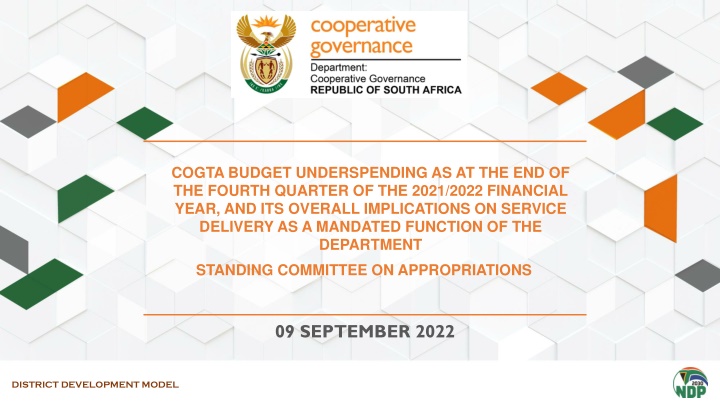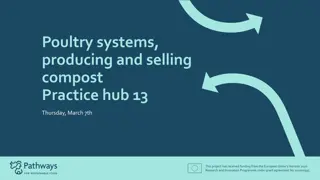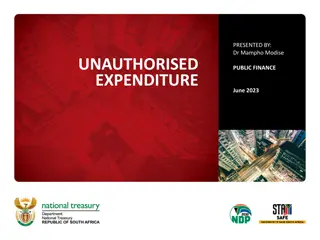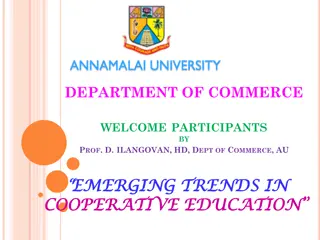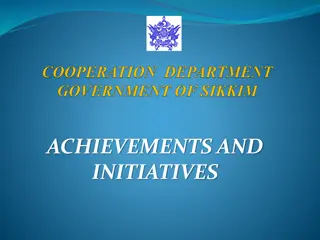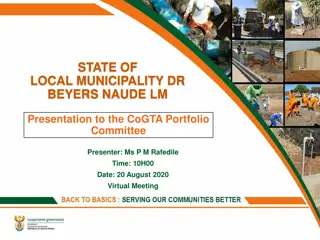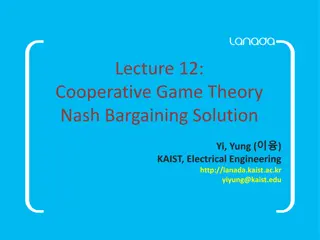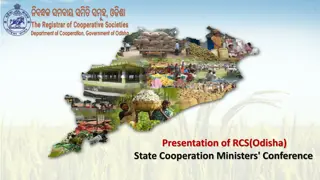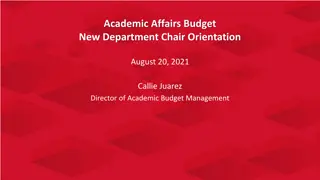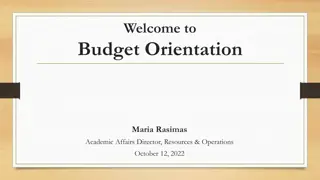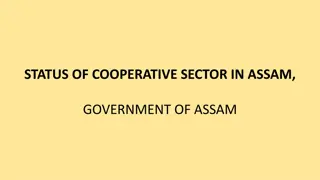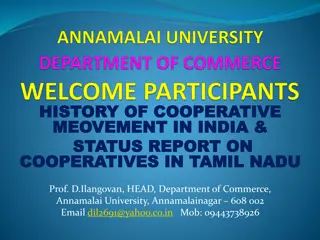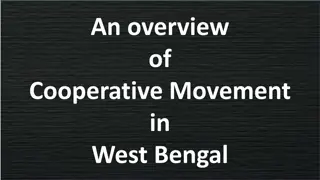Department of Cooperative Governance and Traditional Affairs (COGTA) Budget Underspending Review
The presentation covers the underspending of the Department of Cooperative Governance and Traditional Affairs at the end of the 2021/2022 financial year, highlighting key areas such as departmental expenditure and performance, grants, and challenges faced by municipalities. It discusses the implications of underspending on service delivery, the department's oversight role in supporting struggling municipalities, and recommendations for future improvement to ensure effective service delivery.
Download Presentation

Please find below an Image/Link to download the presentation.
The content on the website is provided AS IS for your information and personal use only. It may not be sold, licensed, or shared on other websites without obtaining consent from the author.If you encounter any issues during the download, it is possible that the publisher has removed the file from their server.
You are allowed to download the files provided on this website for personal or commercial use, subject to the condition that they are used lawfully. All files are the property of their respective owners.
The content on the website is provided AS IS for your information and personal use only. It may not be sold, licensed, or shared on other websites without obtaining consent from the author.
E N D
Presentation Transcript
COGTA BUDGET UNDERSPENDING AS AT THE END OF THE FOURTH QUARTER OF THE 2021/2022 FINANCIAL YEAR, AND ITS OVERALL IMPLICATIONS ON SERVICE DELIVERY AS A MANDATED FUNCTION OF THE DEPARTMENT STANDING COMMITTEE ON APPROPRIATIONS 09 SEPTEMBER 2022 DISTRICT DEVELOPMENT MODEL
PRESENTATION LAYOUT Introduction and Background. Key areas of underspending: Departmental Expenditure and performance (Excluding grants and Transfers) Local Government Equitable Share (LGES) Municipal Infrastructure Grant (MIG) Municipal Systems Improvement Grant (MSIG) Integrated Urban Development Grant (IUDG) Disaster Management Grants The department s oversight role on supporting municipalities that are struggling Challenges, failures and successes of the department Concluding remarks and recommendations 2 DISTRICT DEVELOPMENT MODEL
INTRODUCTION & BACKGROUND On 31 August 2022, the Department of Cooperative Governance and Traditional Affairs received invitation letter from the Chairperson of the Standing Committee on Appropriation (SCOA) inviting the Department to brief the Committee on budget underspending over the past 5 financial years and implications on service delivery as a mandated function of the department. The department was requested make a presentation on the following issues: Summary/ history of the department`s financial and non-financial performance for the past five years (including at the end of the fourth quarter of the 2021/22 financial year); Reasons for underspending and concrete actions that had been taken to address continuous underspending; What the Committee should expect from the department moving forward; Your strategy and plans on economic transformation; Perennial underspending on grants; Issues contributing to municipalities to be under financial distress; The department s oversight role on supporting municipalities that are struggling; Challenges, failures and successes of the department; and Any other matter that can help the committee to perform its oversight duties. 3 DISTRICT DEVELOPMENT MODEL
DEPARTMENT EXPENDITURE & PERFORMANCE TRENDS (EXCLUDING GRANTS AND TRANSFERS) 4 DISTRICT DEVELOPMENT MODEL
DEPARTMENT EXPENDITURE TRENDS EXCLUDING GRANTS AND TRANSFERS Department (Excl. Grants/Transf.) (R Thousand) 1. Administration 2. Local Gov Support Intervention 3. Institutional Development 4. NDMC 5. Community Work Programme Dept TOTAL Compensation of employees Goods and Services Capital Assets Transfers (Households) Payment of Financial Assets Department 2017/18 2018/19 2019/20 2020/21* 2021/22 1,000,000 99.2% 64.2% 83.9% 45.2% 49.3% 72.1% 93.6% 56.6% 96.9% 24.3% 100.0% 98.3% 99.4% 97.9% 95.8% 69.6% 90.8% 99.0% 84.3% 91.8% 71.5% 100.0% 98.9% 98.5% 86.5% 96.8% 98.7% 97.5% 70.9% 128.0% 100.0% 43.6% 31.2% 98.1% 86.1% 80.8% 79.5% 82.4% 88.1% 94.2% 82.4% 99.3% 96.5% 100.0% 94.7% 89.7% 77.5% 29.2% 78.5% 77.3% 88.0% 63.8% 100.0% 68.3% 100.0% 800,000 R Thousand 600,000 400,000 200,000 0 2017/18 210,540 543,185 2018/19 69,812 685,333 2019/20 17,209 677,575 2020/21 183,805 624,318 2021/22 104,820 776,063 Saved Spent Underspending on compensation of employees and goods and services Compensation: The department had an average annual vacancy rate of 10.3% in the period under review which resulted in underspending on Compensation of employees. This can be attributed to slow recruitment processes and an organizational structure not sufficiently aligned to the Department s legal mandate. Goods and Services: Goods and services underspending primarily due to budgets not allocated to priorities, poor procurement planning and delays in finalising procurement processes. 5 DISTRICT DEVELOPMENT MODEL
DEPARTMENT EXPENDITURE TRENDS EXCLUDING GRANTS AND TRANSFERS The Department at the end on the 2021/22 financial year finalized a comprehensive strategic review process. operating model and organizational structure of the Department. Following on this the Department adopted a zero-based budgeting approach for the next MTEF period. Compensation This resulted in a revised 400,000 350,000 300,000 R Thousand 250,000 200,000 The Revised budget allocations prioritized was aimed at capacitating the Department s support and monitoring capability at local level. A dedicated branch responsible for local government operations and support increased capacity to directly engage provinces and municipalities from around 10 employees to 80 employees. 150,000 100,000 50,000 0 2017/18 19,695 288,058 2018/19 3,184 306,841 2019/20 94,843 231,511 2020/21 44,737 326,644 2021/22 20,672 337,454 Saved Spent Compensation of employees The revised organizational structure allocated resources to priority areas to ensure that the Department is able to fully implement its legislative mandate. All vacant posts have been advertised and are in the process of being filled. This will address underspending going forward. Goods and Services 500,000 400,000 R Thousand Goods and Services Procurement plans for the MTEF period are being finalized to ensure that procurement starts before the next financial year commences. SCM policies and processes have been revised to ensure faster procurement turnaround times. These interventions will address under-spending on goods and services over the MTEF period. 300,000 200,000 100,000 0 2017/18 154,571 201,455 2018/19 61,348 330,248 2019/20 81,552 372,855 2020/21 138,348 243,460 2021/22 83,721 391,123 Saved Spent 6 DISTRICT DEVELOPMENT MODEL
DEPARTMENT NON-FINANCIAL PERFORMANCE OVER THE PAST 5 YEARS % APP Achvied and Budget spent The Department performance declined over the 2019/20 FY from 83% to 62%, the Department managed turn its performance towards an upward trajectory, achieving 73% of its targets over the 2021/22 FY. The improvement is due to various systems that have been put in place to address poor performance, which are beginning to bear fruit and this is evident in the improvement in the departmental performance. 100% 90% 80% 70% 60% 50% 2017/18 71% 72.1% 2018/19 83% 90.8% 2019/20 62% 97.5% 2020/21 68% 77.3% 2021/22 73% 88.1% APP Exp The overall performance of the Department over the past 5 FY is at an average of 71,4% - involving a multiplicity of successes and challenges. Non-financial performance (APP) Financial Year Total Targets % Not % Not Achieved Achieved Key to the challenges hampering the Department from achieving some of its goals: Provinces not playing their part and Municipalities not having capacity to implement recommendations. Limited powers of the Minister to enforce compliance on municipalities. (In terms of Chapter 3 of the Constitution) Organisational design and operating model challenges that has since been improved. Achieved Achieved 2017/18 21 15 71% 6 29% 2018/19 18 15 83% 3 17% 2019/20 21 13 62% 8 28% 2020/21 31 21 68% 10 32% 2021/22 37 27 73% 10 27% 7 DISTRICT DEVELOPMENT MODEL
GRANTS: LOCAL GOVERNMENT EQUITABLE SHARE (LGES) 8 DISTRICT DEVELOPMENT MODEL
LOCAL GOVERNMENT EQUITABLE SHARE (LGES) TRENDS 2017/18 TO 2021/22 *CONSTITUTIONALLY, AN UNCONDITIONAL GRANT Funds Offset 1 and/or Stopped 2 Allocation Transferred Year (R 000) (R 000) (R 000) 1,830,554 77,999,135 76,168,581 2021/22 2,580,952 85,683,326 83,102,374 2020/21 3,346,202 1,973,957 1,383,198 68,973,465 62,731,845 57,012,141 65,627,263 60,757,888 55,613,725 2019/20 2018/19 2017/18 The LGES transfers offset against previous year s unspent conditional grants in terms of Section 21 of the Division of Revenue Act (DoRA) by the National Treasury 1: Section 21(1) of the annual DoRA provides for any conditional allocation, or a portion thereof, that is not spent at the end of the financial year to revert to the National Revenue Fund, unless the roll-over of the allocation is approved. Section 21(4) of the annual DoRA provides for the National Treasury to offset any funds that must revert to the National Revenue Fund but not paid into that Fund by the date determined in respect of a municipality, against future transfers of the equitable share or conditional allocations to that municipality. Section 22(2) of the annual DoRA provides for the National Treasury to determine the amount of a municipality s equitable share allocation to be transferred on each date determined in terms of the DoRA after consultation with the national department responsible for local government. There is a need to address underspending of conditional grants impacting on the offsetting of the LGES against previous year s unspent conditional grants and engage with the National Treasury on the LGES offsetting decisions. The LGES transfers stopped in line with Section 216 of the Constitution 2: The National Treasury is empowered by Section 216(2) of the Constitution to stop the transfer of funds (conditional and non-conditional grants) to any organ of state that commits a serious or persistent breach of the measures prescribed to promote transparency, accountability and the effective financial management of the economy, debt and the public sector. The dataset on the municipalities and offset amounts is available 9 DISTRICT DEVELOPMENT MODEL
GRANTS: MUNICIPAL SYSTEMS IMPROVEMENT GRANT (MSIG) 10 DISTRICT DEVELOPMENT MODEL
MUNICIPAL SYSTEMS IMPROVEMENT GRANT (MSIG) - EXPENDITURE TRENDS 2017/18 TO 2021/22 Allocation Spent Unspent Funds Year (R 000) (R 000) (R 000) 89,388 91,725 25,627 21,367 52,602 135,302 119,774 111,062 115,116 103,249 45,914 28,049 85,435 93,749 50,647 2021/22 2020/21 2019/20 2018/19 2017/18 TheMSIG underspent mainly due to the lack of the appropriate identification of support areas for the MSIG programme and delays in the procurement of required services. The Department will adopt a forward planning approach on the envisaged MSIG-funded support projects to ensure a seamless implementation of technical support to municipalities; and It should be noted that the current MSIG-funded technical support projects, namely; 1. piloting and validation of the prototype (generic) staff establishments of municipalities (macro and micro structures) according to different powers and functions of different categories of municipalities; 2. improvement of data management; 3 improvement of records management; and 4. cost of supply on water provision, are multi-year projects and will also address the procurement challenges identified in the MSIG. It is further envisaged that these projects: 1. the rollout of the prototype staff establishment; 2. improvement of data management; 3. improvement of records management; and 4. cost of supply on water provision, will be rolled out to other municipalities. 11 DISTRICT DEVELOPMENT MODEL
MUNICIPAL SYSTEMS IMPROVEMENT GRANT (MSIG) ACHIEVEMENTS 2017/18 TO 2021/22 2016/17 to 2017/18: Simplified Revenue Plan (SRP): The Department supported 30 municipalities through the implementation of the Simplified Revenue Plan (SRP) project. The activities carried out through the SRP project included: data cleansing initiatives (such as account consolidation); ensuring the meters are read on a monthly basis; ensuring correct billing of services, reviewing progress on government debt recovery; training of staff in basic daily accounting duties; ensuring that credit control policy is implemented through service restrictions and cut-offs; verifying indigents; ensuring that revenue steering committees are established for continuation of progress after project close-out; and assisting with remedial actions following the Auditor-General s findings. 2017/18 to 2018/19: Municipal Property and Consumer Database Project: The Department developed an integrated property and consumer database to be used by municipalities in credit control, debt collection and indigent management. Prototype Staff Establishment: The Department developed prototype (minimum staffing requirements) staff establishments (macro and micro structures) according to different functions and powers of different categories of municipalities. The final deliverables on this project were as follows: micro staff establishments design, job evaluation - macro structures, job profiling - microstructures, consolidated job profiling and evaluation report, and an implementation plan. The next phases of the project is for the Department to pilot and validate the prototype (generic) staff establishments of municipalities (macro and micro structures) according to different powers and functions of different categories of municipalities and undertake a national rollout of the prototype staff establishment in municipalities. Amalgamated Municipalities: The Department supported the 22 amalgamated municipalities through the MSIG on transitional matters. These are municipalities whose boundaries were re-determined by the Municipal Demarcation Board (MDB) in 2013 and 2015. 12 DISTRICT DEVELOPMENT MODEL
MUNICIPAL SYSTEMS IMPROVEMENT GRANT (MSIG) ACHIEVEMENTS 2017/18 TO 2021/22 2018/19 to 2019/20: Simplified Revenue Plan (SRP): The Department supported additional 42 municipalities. The activities carried out through the SRP project included: data cleansing initiatives (such as account consolidation); ensuring the meters are read on a monthly basis; ensuring correct billing of services, reviewing progress on government debt recovery; training of staff in basic daily accounting duties; ensuring that credit control policy is implemented through service restrictions and cut-offs; verifying indigents; ensuring that revenue steering committees are established for continuation of progress after project close-out; and assisting with remedial actions following the Auditor-General s findings. Integrated Urban Development Framework (IUDF): The Department supported Intermediate Cities Municipalities (ICMs) in the development of Capital Expenditure Frameworks (CEFs). 2020/21 to 2021/22: District Development Model (DDM): The Department implemented the District Development Model (DDM) approach in eThekwini, OR Tambo and Waterberg districts. Data Management, Records Management and the Cost of Supply Studies on Water Provision: The Department identified 8 municipalities for support on the improvement of data management; 30 municipalities for the improvement of records management and 10 municipalities for the cost of supply studies on water provision. The Department has commenced with the provision of technical assistance in these municipalities in respect of the identified areas of support. 13 DISTRICT DEVELOPMENT MODEL
GRANTS: MUNICIPAL INFRASTRUCTURE GRANT (MIG) 14 DISTRICT DEVELOPMENT MODEL
MIG EXP PERFORMANCE (2017/18- 2021/22) 2017/18 2018/19 2019/20 Expenditure as % of allocation 89.18% 88.42% 89.84% 98.14% 87.23% 97.47% 81.06% 89.03% 93.57% 91.56% Expenditure as % of allocation 93.88% 97.81% 61.54% 95.72% 80.95% 99.28% 79.01% 91.19% 91.20% 90.48% Expenditure as % of allocation 78.29% 84.32% 45.52% 89.02% 70.46% 90.86% 65.52% 73.23% 73.93% 79.08% Prov Allocated (R'000) Expenditure (R'000) Allocated (R'000) Expenditure (R'000) Allocated (R'000) Expenditure (R'000) 3,121,796 764,068 526,578 3,463,910 3,352,516 1,855,061 488,020 1,782,328 536,975 15,891,252 2,783,934 675,625 473,089 3,399,413 2,924,388 1,808,087 395,599 1,586,770 502,451 14,549,356 2,997,685 761,828 500,440 3,311,354 3,218,586 1,791,352 470,291 1,723,707 512,442 15,287,685 2,814,245 745,181 307,964 3,169,669 2,605,563 1,778,492 371,558 1,571,887 467,333 13,831,893 2021/22 3,060,840 770,107 312,842 3,215,816 2,944,637 1,813,621 457,801 1,797,741 442,698 14,816,103 2,396,465 649,352 142,392 2,862,792 2,074,693 1,647,840 299,966 1,316,542 330,646 11,720,688 EC FS GP KZ LP MP NC NW WC TOTAL 2020/21 Expenditure as % of allocation 91.28% 87.27% 69.80% 96.94% 89.16% 98.13% 66.55% 89.70% 94.40% Cumulative Exp incl. Rollover 2,604,123 618,398 204,420 3,563,584 2,861,588 1,832,232 346,371 1,525,171 436,195 Expenditure as % of allocation 82.65% 79.35% 72.58% 99.39% 92.28% 96.96% 73.36% 81.18% 95.99% 89.73% Prov Allocated (R'000) Expenditure (R'000) Allocated (R'000) Outbreak of Covid-19 had an impact on the last tow quarters of the municipal financial years 2,866,318 797,376 349,140 3,158,316 2,977,399 1,698,153 452,552 1,754,813 436,998 2,616,478 695,847 243,684 3,061,794 2,654,691 1,666,397 301,189 1,574,113 412,530 3,150,667 779,352 281,652 3,585,280 3,100,822 1,889,630 472,148 1,878,769 454,428 15,592,748 EC FS GP KZ LP MP NC NW WC TOTAL 100%-90% 89% - 80% below 79% Source: MIG Monthly DoRA reports for 2017/18 2021/22 14,491,065 13,226,723 91.28% 13,992,082 15
MIG NON-FINANCIAL PERFORMANCE ON MAIN CATEGORIES (2017/18- 2020/21) Sector Infrastructure % R'000 Category 2017/18 2018/19 2019/20 2020/21 Total 68,045 64 614 53 469 Water (Households) 72,028 140,073 Water 38 19,454,294.85 54,225 52,322 42 852 43 979 Sanitation (Households) Roads (kilometers) 106,547 Sanitation 19 9,727,147.42 Roads & Storm water 1,431 1,058 1,474 1,145 5,108 29 14,846,699 24 4 16 Community (completed projects) Community (completed projects) Solid (completed projects) Sport & Facilities (completed Work opportunities and Full-time Lighting 14 58 Street/Com munity Lighting Community Facilities Solid Waste Facilities Sport & Rec Facilities Sub - Total PMU contribution TOTAL 1 511,955.13 127 29 44 Facilities 94 294 6 3,071,730.77 23 0 11 Waste 9 43 2 1,023,910.26 115 11 17 Recreation 38 181 5 2,559,775.64 161,116 104,154 152,838 151,116 569,224 100 51,195,513 Source: MIG Annual Reports for 2017/18 2020/21 Note : 2021/22 information is still being prepared as part of the 2021/22 MIG Annual Report development process currently underway 2,133,146 53,328,659 16
PROGRESS ON MAIN CHALLENGES NO. CHALLENGE PROGRESS Implementing of cost reimbursement in 18 municipalities that requires that MIG funding is only released to municipalities if invoices has been technically verified as completed by a verification team (DCoG/MISA, relevant provinces) Funds not being used for the intended purpose - Most municipalities under financial distress utilize transferred MIG funding to cover operational expenses 1. Provinces assist these municipalities with the implementation of their financial recovery plans to improve revenue MISA as part of their roles & responsibilities on the MIG framework is assisting municipalities with the technical reports reviews and business case development to advance a credible pipeline of MIG capital projects implemented by municipalities; Poor MIG value chain execution resulting in the lack of pipeline of MIG projects 2. MISA engineers are part of the sector appraisal committees of projects to be included in the MIG Project Implementation Plans; Deliberate in the conditional grants review process (facilitated by National Treasury) to allow grants such as MIG to fund enabling municipal infrastructure to promote economic development 3. Low economic development impact of pro-poor grants such as the MIG Engagement currently underway with DWS, that administers WSIG & RBIG, aimed at integration of infrastructure grants planning, budgeting & implementation alignment 17
PROGRESS ON MAIN CHALLENGES NO. CHALLENGE PROGRESS DCoG to retain the allocations (implement a 6B for MIG) of poor performing municipalities (MIG expenditure and service delivery) and implement on behalf of municipalities on priority infrastructure projects (repairs and refurbishment of water service and waste management infrastructure) on behalf of municipalities. Failure of municipal infrastructure, largely due to poor budgeting and expenditure on Capital Grants. 4 MISA has developed a design office, currently piloted in OR Tambo District Municipality, that will in the future serve as consultants services where technical designs of municipalities are undertaken and this will build capacity, cost of service and reduce reliance on consultants, Outsourcing of technical skills by municipalities in infrastructure implementation 5. A PUBLIC INFRASTRUCTURE UNIT COST GUIDELINE , collaboration between MISA & UCT, has been reviewed & updated for municipalities to benchmark cost of services & extended their infrastructure investment opportunities. 6. Leakages Inflated pricing in the development of Infrastructure 18
OPPORTUNITIES TO ADDRESS MAIN CHALLENGES NO. CHALLENGE OPPORTUNITY Delayed procurement processes to implement service providers (professionals and contractors) and municipalities not following procurement processes ending up in litigations and project implementation delays Provincial Treasuries give greater guidance to municipalities in municipal procurement processes and sit in procurement decision processes to decrease the levels of litigations 1. Although municipalities are able to utilize up to 5% of the MIG allocations to acquire project management skills some municipalities still do not have required contract management, project management and technical skills to manage and oversee the implementation of projects Provinces and or MISA to be part of appointment process and panels of Technical Managers to ensure the consideration of appropriate technical skills 2. Not understanding the depth of assets owned by municipalities in order to develop response mechanism. Inefficient management (technical and financial) of infrastructure resulting in excessive non-revenue water and electricity. Establish a Universal Infrastructure Information Management System (i.e. MIPMIS) and ensure that all municipalities are equipped to utilize the tool/system for their planning/implementation/operational benefit. 3. Classify certain infrastructure that is strategic and failing or neglected assigning the operation and maintenance of this infrastructure to a special purpose entity / vehicle or implementing agent (as per the recommendation from the Water and sanitation Master Plan). Neglect and or poor operation and maintenance of strategic municipal infrastructure assets, adversely impacting service delivery and ultimately undermining socio-economic development 4. 19
MEASURES TO ADDRESS MAIN CHALLENGES NO. CHALLENGE RECOMMEDNATION/ OPPORTUNITY Build a shared service model where there is a district project office that assumes planning and implementation of capital & maintenance projects and that has an ability to operate priority infrastructure. Lack of skilled personnel in municipalities to plan, implement and for operation & maintenance of infrastructure assets 5. Encourage greater private sector participation in municipal infrastructure development, to close funding gap. Leverage on opportunities of Budget Facility for Infrastructure by planning for high magnitude projects with wide benefit that includes repairs and maintenance. Poor expenditure patterns on Operations & Maintenance of infrastructure. Inefficient expenditure of infrastructure grants, evidenced by project schedule and budget over-runs along with poor quality index of infrastructure. 6.. Leverage existing municipal infrastructure grants such as the to prioritize asset management planning (MIG up to 5% of alloc) implementation of Repair & Maintenance of infrastructure (MIG up to 10% of alloc.) . Improve the uptake of to above by municipalities within the MIG 20
GRANTS: INTEGRATED URBAN DEVELOPMENT GRANT (IUDG) 21 DISTRICT DEVELOPMENT MODEL
INTEGRATED URBAN DEVELOPMENT GRANT Municipalities participate in this grant through an application process. In order for municipalities to qualify for IUDG, they must meet certain minimum requirements currently there are 8 municipalities on IUDG 39 local municipalities have been classified as ICMs based on population density and GVA. 1 Be classified as an Intermediate City Municipality 2 Meet a set of five minimum conditions See below Prepare a 10-year Capital Expenditure Framework and associated 3-year capital programme Long term infrastructure investment plan in line with short term priorities of the IUDF 3 A municipality must meet or exceed the threshold performance on all 5 the indicators in order to qualify for the IUDG Qualification indicator Indicator Description Number of person days that S56 and S57 posts were unfilled over the past two years of 10% or less as a percentage of person days of S56 and S57 posts Top management stability Unqualified audit finding (with or without findings) in the two most recent audits Audit finding UIFWE of 7.5% or less of operating budget on average over the past two financial years Unauthorised, irregular, fruitless & wasteful expenditure (UIFWE) Capital expenditure of at least 70% of budget on average over the past two years Capital budget expenditure Submission of SDBIP performance reporting on time in at least 6 of the 8 quarters in Section 52 (d)performance reporting DISTRICT DEVELOPMENT MODEL the previous two years 22
INTEGRATED URBAN DEVELOPMENT GRANT (IUDG) EXP 2020/21 2020/21 Financial Year Transferred (R 000) Municipality Total allocation (R 000) DORA Adjustment Total Exp (R 000) % 350 966 159 963 315 856 164 617 91,1 100 Polokwane Umhlathuze 350 966 161 955 4 318 1 992 91 794 100 Steve Tshwete 92 937 91 794 1 143 50 328 50 320 100 Sol Plaatje 50 955 627 46 906 46 792 99,8 Stellenbosch 47 489 584 57 927 100 Drakenstein 58 649 57 927 722 118 293 100 123 272 Mogale City 118 293 1 473 64 509 64 956 100 Ray Nkonyeni 65 313 804 936 368 915 534 97,8 TOTAL 948 031 11 663 23 DISTRICT DEVELOPMENT MODEL
INTEGRATED URBAN DEVELOPMENT GRANT (IUDG) EXP 2019/20 TO 2021/22 2021/22 Financial Year Transferred to date Municipality Total allocation (R 000) Total Exp (R 000) % (R 000) Polokwane 397 532 397 532 387 933 97.6 130 750 Umhlathuze 134 750 131 260 100 75 218 Steve Tshwete 75 218 75 077 99,8 54 266 100 Sol Plaatje 66 266 54 266 56 941 Stellenbosch 56 941 54 614 95,91 52 256 Drakenstein 59 256 52 257 100 142 974 Mogale City 142 974 142 974 100 99 131 Ray Nkonyeni 76 131 98 016 98,9 996 397 TOTAL 1 009 068 1 009 068 98,7 24 DISTRICT DEVELOPMENT MODEL
MAIN CHALLENGES IMPACTING ON PROJECT IMPLEMENTATION KEY CHALLENGES IDENTIFIED PROPOSED INTERVENTIONS Slow progress on some sites. Poor performance of contractors which has led in termination of some of the contractors and therefore delays in the projects. Contractors facing cashflow problems and therefore unable to pay labourers leading to further delays on projects. Community unrest arising from appointment of labourers and Community Liaison Officers. Delays in procurement of service providers for new projects. Poor performing contractors have been issued with notices of slow progress and have been given prescribed days to turn around, those that are unable to turn the situation around will be subjected to termination. Contractors that have not finished their projects within the stipulated time taking into account extensions of time granted have been subjected to penalties as stipulated in the contract. Some municipalities have initiated a database system for all emerging subcontractors that will be eligible to participate in sub-contracting on projects implemented. Intervention meetings have been held with poor performing service providers. Close monitoring through regular contractor/consultant meetings. Contractors urged to correct the defects and put measures in place in order to accelerate progress. site visit and monthly 25 DISTRICT DEVELOPMENT MODEL
GRANTS: DISASTER MANAGEMENT GRANT 26 DISTRICT DEVELOPMENT MODEL
DISASTER GRANTS WITHIN THE NDMC Disaster Response Grants are unallocated allocations in terms of the Division of Revenue Act; therefore, are only released in the event of a classified disaster as a top-up fund when organs of state are unable to deal with the effects of the disaster and grant conditions have been met. YEAR GRANT PURPOSE TOTAL ALLOCATION TRANSFERRED REMARKS 2017/2018 Mun. Response Grants & Prov. Drought (EC, NC, WC) R423 713 000 R423 713 000 100 % transfer to grants recipients (Municipalities and Provinces) Mun. Recovery Grants & Prov. Sinkholes & Storms (GP, KZN) R 42 451 000 R 42 451 000 R16.3 allocation surrendered to national fiscus million KZN 2018/2019 Mun. Recovery Grant Storms & drought (EC, FS, WC & KZN) R1 284 364 000 R1 284 364 000 Municipal Disaster Recovery Grant Prov. Response Grant Drought ( NC) R123 591 000 R 84 677 863 Remaining balance of R 38 913 137 2019/2020 Mun Response Grants & Prov. Covid-19 (9 prov. DOHs &) R 466 392 000 R 466 392 000 2019/2020 converted to PDRG MDRG 27 DISTRICT DEVELOPMENT MODEL
DISASTER GRANTS WITHIN THE NDMC YEAR GRANT TYPE PURPOSE TOTAL ALLOCATION TRANSFERRED REMARKS 2020/2021 Municipal & Provincial Response Grants Covid-19 & drought R 492 429 000 R150 970 000 Remaining balance of R 202 970 000 2021/2022 Municipal & Provincial Response Grants Drought & storm Eloise R498 788 000 R378 370 989,93 Remaining balance R 120 417 010.07 KEY CHALLENGES IDENTIFIED PROPOSED INTERVENTIONS Failure/ reluctance by organs of state to invoke emergency procurement arrangements therefore unable to implement response projects within 6 months as per the disaster grant frameworks, due to potential audit implications Allocated funds not utilized by organs of state and being surrendered to the national fiscus Lack of technical capacity within organs of state to implement intervention measures. Governance related matters (poor financial management, vacant critical positions, council not seating to pass allocated budgets) Challenges on following up on the rand - monitoring of implemented projects that is exacerbated by lack of oversight and intervention by Accounting Officers within the funded organs of state Failure to report on spending in term of prescribed procedures Strengthen Project Management Units to monitor and report on all funded projects through Grant Funding Programmes through technical support from MISA, the DDM and Rapid Response Teams Strengthen participation of various stakeholders through activation of joint operation centres or other relevant structures for effective response and recovery. Organs of state to report on spending of grants in terms of DORA and s24 of the Disaster Management Act, 57 of 2002 Strengthencapacity within the NDMC in terms of resources and systems to enhance grant management process in support of organs of state 28 DISTRICT DEVELOPMENT MODEL
ISSUES CONTRIBUTING TO MUNICIPALITIES TO BE UNDER FINANCIAL STRESS Issues contributing to municipalities to financial distress in municipalities: Unfunded Budgets Negative Audit Outcomes over successive consecutive years High unresolved UIFW expenditure incurred Defaulting on payments to creditors e.g. Eskom and Water Board Debt: Government debt owed to municipalities Poor revenue collection below the Treasury norm of 95% Lack of capacity in Budget Treasury Offices; Slow Infrastructure Grants expenditure - MIG and WSIG, INEP. Bloated organizational structures resulting in high salary bills Challenges with billing, illegal connections and high water and electricity losses due to failing infrastructure 29 DISTRICT DEVELOPMENT MODEL
THE DEPARTMENTS OVERSIGHT ROLE ON SUPPORTING MUNICIPALITIES THAT ARE STRUGGLING The interventions measures by the department to support municipalities to address root causes for financial health deterioration includes but not limited to: Lapse in governance is observed as a main driver in the stabilisation of administration, financial management and provision of service delivery. To address the challenges the Municipal Support and Intervention Plans (MSIPs) Framework has been developed by CoGTA, Provinces, SALGA and National Treasury to provide guidance on the development, implementation and the monitoring of the MSIPs. To address the inability to maximize revenue potential, the Department appointed a panel of service providers to undertake a data management (revenue) project in 8 municipalities to address the challenge of the inaccuracy and completeness of billing and revenue leakages. Furthermore, the Department is embarking on the cost of supply study on water provision in 10 municipalities aimed at assisting municipalities to design tariff settings that could be cost reflective. The department has implemented National Responsible Citizenry campaign, which aimed at encouraging the consumers to pay municipal services. It is expected that municipalities will institutionalise the campaign to encourage their local communicates to pay for municipal service. The Department also intends rolling out the prototype staff establishment project in municipalities to address challenges in the organograms, which will inter alia address bloated organograms. The Department collaborate with National Treasury, provincial counterparts to support municipalities with the development and implementation of financial recovery plans. The National Treasury is taking a lead on assisting municipalities to have credible budgets and measures to address unfunded budgets. 30 DISTRICT DEVELOPMENT MODEL
SUCCESSES OF THE DEPARTMENT The process of putting in place institutional arrangements for the District Development Model are progressing well, the Department managed to oversee the development of 40 district and six (6) Metro One Plans. The State of Local Government Report was developed and tabled in Cabinet, highlighting municipalities that are Dysfunctional, Medium to high Risk, Low Risk and Stable. This led to the development of Municipal Support and Interventions Packages for all 258 municipalities in the country. The Department developed a DDM implementation framework incorporating gender responsive indicators aligned to the NSP on GBVF. Working with MISA, the Department continued to provide support to the 44 district municipalities of the country to have access to sustainable services through the strengthening of their capacity to provide reliable infrastructure in a manner that creates jobs for local communities and contributes to economic growth. Due to repeated calls over a long period of time for legislation to provide for oversight to be conducted on municipal councils, a new section 79A has been inserted in the Structures Amendment Act to provide for the establishment of the Municipal Public Accounts Committees (MPACs). The Community Work Programme continues to contributed to providing our poorest communities in most of the municipalities across South Africa with an employment safety net. Through the implementation of the Indigent Policy, 40 municipalities were supported to update their indigent registers. The Department completed the development of the Intergovernmental Monitoring, Support and Interventions (IMSI) Bill for further processing. The Department developed the Integrated Urban Development Framework (IUDF) to promote a coordinated response to the spatial legacy and enhance integration across planning frameworks and all the spheres of government. 31 DISTRICT DEVELOPMENT MODEL
CONCLUDING REMARKS AND RECOMMENDATIONS The Department adopted a zero-based budgeting approach for the next MTEF period, which will address underspending and will ensure that funding is allocated to priority areas. The Department will make amendments to the MSIG framework during the October 2022 amendment window to address the underspending. To assist the struggling municipalities, the Municipal Support and Intervention Plans (MSIPs) Framework has been developed by CoGTA, Provinces, SALGA and National Treasury to provide guidance on the development, implementation and the monitoring of the MSIPs. It is recommended that the Standing Committee on Appropriations note the Underspending of Budget challenges experienced in the in the department and measure put in place to remedy the recurrence of the situation. 32 DISTRICT DEVELOPMENT MODEL
